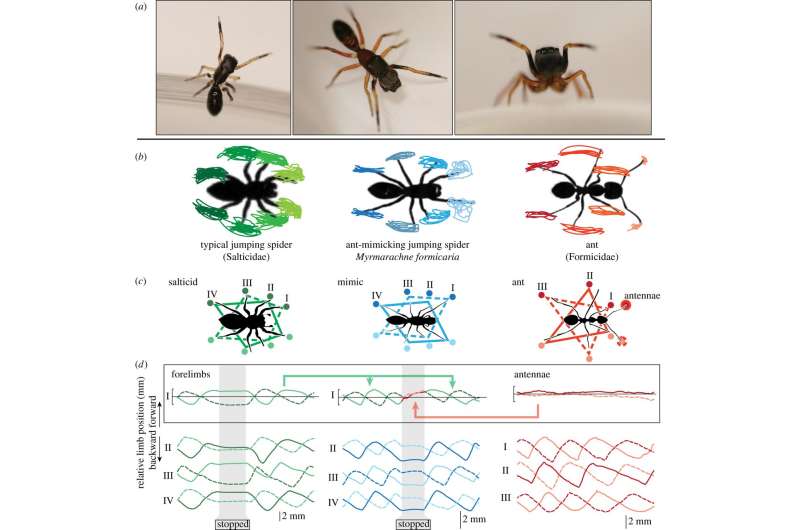July 12, 2017 report
Spider walks like an ant and raises front legs to mimic ant antenna

(Phys.org)—A small team of researchers at Cornell University has found that a certain species of spider raises its front legs periodically to mimic the look of antennae on ants. In their paper published in Proceedings of the Royal Society B, the group reports that the spider also walks in a zig-zap pattern similar to ants.
As the researchers note, small spiders tend to fall prey to a wide variety of predators, and because of that, many have learned to behave in novel ways that help them survive. In this new effort, the researchers found that the spider Myrmarachne formicaria, which has evolved to resemble an ant, has also learned to mimic ant behavior to increase its chances of survival.
Ants, the researchers also note, are a tough meal choice for many predators—some bite, some have chemical defenses and most are quite aggressive to boot. And if that is not enough to deter large spiders and other creatures from eating them, most ants belong to a nest with members that come to the aid of those under attack. It is no wonder that many creatures mimic them to avoid being eaten.
To learn more about mimicry by the spiders, the researchers set up video cameras to capture them in action as they went about their lives in the wild. In so doing, they discovered that the spiders wander about on the ground in patterns very similar to those of ants—which do so because they follow a pheromone trail.
The team also captured sample spiders and studied them in the lab—close-up, high-speed video revealed that the spiders lifted their front two legs periodically as they walked, just often enough to confuse prey into believing that the legs were antennae, mimicking ant behavior. To test how well the behavior worked, the researchers placed predators in with the spiders and recorded the action. They found that the predators attacked the spiders less often than they attacked regular jumping spiders—but about just as often as they attacked real ants. This, the researchers suggest, indicates that the mimicry by the spiders is quite effective.
More information: Paul S. Shamble et al. Walking like an ant: a quantitative and experimental approach to understanding locomotor mimicry in the jumping spider Myrmarachne formicaria, Proceedings of the Royal Society B: Biological Sciences (2017). DOI: 10.1098/rspb.2017.0308
Abstract
Protective mimicry, in which a palatable species avoids predation by being mistaken for an unpalatable model, is a remarkable example of adaptive evolution. These complex interactions between mimics, models and predators can explain similarities between organisms beyond the often-mechanistic constraints typically invoked in studies of convergent evolution. However, quantitative studies of protective mimicry typically focus on static traits (e.g. colour and shape) rather than on dynamic traits like locomotion. Here, we use high-speed cameras and behavioural experiments to investigate the role of locomotor behaviour in mimicry by the ant-mimicking jumping spider Myrmarachne formicaria, comparing its movement to that of ants and non-mimicking spiders. Contrary to previous suggestions, we find mimics walk using all eight legs, raising their forelegs like ant antennae only when stationary. Mimics exhibited winding trajectories (typical wavelength = 5–10 body lengths), which resemble the winding patterns of ants specifically engaged in pheromone-trail following, although mimics walked on chemically inert surfaces. Mimics also make characteristically short (approx. 100 ms) pauses. Our analysis suggests that this makes mimics appear ant-like to observers with slow visual systems. Finally, behavioural experiments with predatory spiders yield results consistent with the protective mimicry hypothesis. These findings highlight the importance of dynamic behaviours and observer perception in mimicry.
Journal information: Proceedings of the Royal Society B
© 2017 Phys.org


















